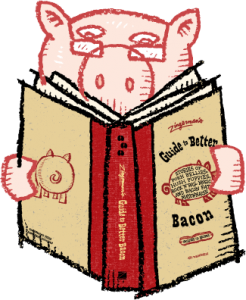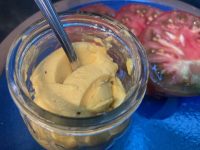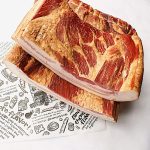Bacon Recipes: Mush and Bacon
Anson Mills Mush and Bacon
This is one of those dishes that I’d seen mentioned many times in old cookbooks, but never actually took the time to make. It sounds so simple and unexciting that I wasn’t all that excited. I’d always been interested in polenta and grits, whereas mush sounded like some kind of backwoods mountain food. And the sad reality is that if you were to make mush with most any commercial cornmeal on the market, you wouldn’t think it was much (or is that “mush”?) either.
If you aren’t familiar with the name, mush is an old American dish that’s basically just plain-and-simple  cooked cornmeal porridge. It’s pronounced like “rush,” not “push.” Pretty much anything you do with grits or polenta you can do with mush. Which is why the first question that most everyone who doesn’t know the dish asks, “What’s the difference between mush, polenta and grits?”
cooked cornmeal porridge. It’s pronounced like “rush,” not “push.” Pretty much anything you do with grits or polenta you can do with mush. Which is why the first question that most everyone who doesn’t know the dish asks, “What’s the difference between mush, polenta and grits?”
And a fine question it is. In a broad sense you can certainly stick all three into the same category— porridge made of dried ground corn. Taking the level of detail down a bit, grits tend to be the most coarsely ground, polenta more finely so, and cornmeal for traditional mush finer still. (There are of course exceptions, which is . . . fine.) While the casual cook might think that they sound like pretty much the same thing by different names, in the American South grits and mush are very definitely different. And for reasons I don’t yet fully understand, grits are more or less unknown in the culinary traditions north of the Mason-Dixon line, while mush is all over old New England as well as Southern cooking.
I can’t really recall why one day I set out to make mush. Blessedly, the first time I did it I used some of the most amazing cornmeal available and topped it with some of the best bacon and bacon fat (Benton’s, actually) you can find. Given how I preach about the power of superior ingredients I shouldn’t have been so shocked at how good it was. I made mush five more times in the next two weeks, and I’ve continued to cook it regularly when- ever I’ve got the time. There’s really no work to it—you just have to get up and stir every 15 minutes or so (or, alternatively, use a non-stick pot).
Let me emphasize that this recipe, then, isn’t really just about making mush for its own sake. Since the ingredients are really just cornmeal, water and salt it’s only going to be as good as the corn that goes into it: do it with sit-on-the-shelf, super-processed, “germless” Quaker cornmeal and it’s going to be about as exciting as white toast with bad butter. This here dish—as you might have noticed from its well-branded title—is all about mush made from Anson Mills cornmeal. The bacon is great on top, but without great cornmeal it’s like putting an outstanding olive oil atop so-so pasta. You need the two in concert for the dish to work.
Almost anything goes with mush—certainly most any sautéed or roasted vegetable would be good. But what I’ve been making at home is a dish from the Civil War era—just mush served up with fried bacon pieces and a lot of bacon fat. Which bacon you use is really up to you since it’s so simple and so much the featured flavor along with that of the corn.
Ingredients:
- 4 cups water
- 1 cup Anson Mills stone-ground organic yellow cornmeal
- 1 teaspoon coarse sea salt, plus more to taste
- 1⁄4 pound bacon, chopped
- Freshly ground Tellicherry black pepper to taste
Procedure:
Put the water in a heavy stockpot and warm it over medium heat. When the water approaches the boiling point, start adding the cornmeal a bit at a time, stirring to keep the consistency smooth. Add salt and continue to stir well. Bring the mixture to a light boil and cook, stirring regularly, for a few minutes until the water and meal are well combined. Reduce the heat to very low, cover and cook for as many hours as you can. Simply lift the cover and stir gently 3 or 4 times an hour. If you can keep the heat low enough and you’re around the house anyways, there’s no reason not to cook it for a good 2 to 4 hours. The longer you let the cooking go with a great fresh cornmeal like Anson Mills, the better it’s going to taste.
When you’re ready to serve, put the bacon into a hot skillet and cook it until lightly browned. When the bacon’s almost done, put the mush into warm serving bowls. Pour the bacon and fat over the top, pass the salt and pepper and enjoy!
Serves 2 to 4 as a main course, depending on how hungry you are, or 6 to 8 as an appetizer.
Four Other Ways to Make Mush with Bacon
There are really only two reasons I can think of not to make mush: not being able to get good cornmeal, and not having time to cook it. So once you’ve decided to make it, I say you might as well cook a lot of it. It takes no longer to stir a double batch than a single one. It keeps well, too, so you can reheat at will. And there are actually a whole mess of different ways to serve mush other than just eating it on its own. Here’s a series of options to consider.
Option 1: With oysters
Just before the bacon is done, add a mess of shucked oysters to the skillet—anywhere from 4 to 14 per person, depending on how flush (and hungry) you’re feeling.
Option 2: With fried egg
Just lay it atop everything else. It’s a great alternative to the classic bacon, grits and eggs.
Option 3: Fried mush
So much of this book is about fried bacon, but mush is often served that way, as well—cooked, cooled and then cut into slabs and fried up the next day. Bacon fat, sprinkles of crisp bacon and maybe some grated cheddar would be the obvious Southern choices. But you could certainly top yours with butter or olive oil, instead. I like to serve fried mush atop fresh spinach that has been sautéed, as it should be, in bacon fat. Or try caramelized Vidalia or other sweet onions.
Option 4: Sweet mush
You can serve this for breakfast or dessert, topped with maple or sorghum syrup. It’s delicious any time of day.
Up in New England, sweet mush is commonly known as “hasty pudding.” It seems to be a precursor of Indian pudding, which required more ingredients and started to get closer to the steamed puddings the colonists craved from back home in Britain. In New England, hasty pudding is often (though not always) eaten with a sweet topping, such as maple syrup. This is fine, but I swear by the Southern version, which is topped with sorghum syrup. The official line from Anson Mills’ Glenn Roberts on the subject is: “Yummy.” “My daughter Ansley would fight for this dish,” he says, “and she’s a pacifist.”
The sweetness and corniness of the corn come up against the slightly sour, just a bit bitter, deep dark sweetness of the sorghum. (Glenn suggested the term “whiplash” to describe this sweet/sour phenomenon, just as it was used to describe the best Madeira back in Colonial times.)
Mush would be good with molasses too, I’m sure. And any of the syrup options is good with a bit of fried bacon thrown on top, of course . . .
To read more about Ari’s appreciation for cornmeal mush, check out his essay on page 7 of the May/June 2015 Zingerman’s Newsletter.




Zingerman’s Art for Sale